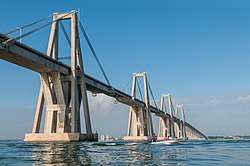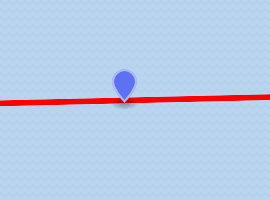General Rafael Urdaneta Bridge
The General En Jefe Rafael Urdaneta Bridge is located at the Tablazo Strait outlet of Lake Maracaibo, in western Venezuela. The bridge connects Maracaibo with much of the rest of the country. It is named after General Rafael Urdaneta, a Venezuelan hero of Independence.
General Rafael Urdaneta Bridge | |
|---|---|
 | |
| Coordinates | 10°34′27.38″N 71°34′33.73″W |
| Carries | vehicles |
| Crosses | Tablazo Strait |
| Locale | Maracaibo, Zulia, Venezuela[1] |
| Characteristics | |
| Design | Cable-stayed bridge[1] |
| Material | Reinforced concrete[1] |
| Total length | 8.7 kilometres (5.4 mi)[1] |
| Height | 86.6 metres (284 ft)[1] |
| Longest span | 235 metres (771 ft) x 5 |
| No. of spans | 135 |
| History | |
| Designer | Riccardo Morandi |
| Construction start | 1958[1] |
| Construction end | 1962[1] |
| Construction cost | Bs. 350 million[2] |

| |
Design and construction
Made of reinforced and prestressed concrete, the cable-stayed bridge spans 8,678 metres (5.392 mi) from shore to shore. The five main spans are each 235 metres (771 ft) long.[3] They are supported from 92-metre (302 ft) tall towers, and provide 46 metres (151 ft) of clearance to the water below.[4] The bridge carries only vehicles.
The competition to design the bridge started in 1957 and was won by Riccardo Morandi, an Italian civil engineer. Morandi's was the only concrete design out of twelve entries, and was expected to be less expensive to maintain, as well as providing valuable experience of prestressed concrete technology for Venezuela.[4] Construction was carried out by several companies, including Grün & Bilfinger, Julius Berger, Bauboag AG, Philipp Holzmann AG, Precomprimido C.A., Wayss & Freytag and K Ingeniería.
According to eminent bridge engineer Michel Virlogeux:[3]
the Lake Maracaibo Bridge deserves to be part of the series of the most famous bridges over the world, with the Golden Gate Bridge, the bridge over the Firth of Forth, the Brooklyn Bridge, and the Garabit Viaduct.
History
It was opened on 24 August 1962 by the then-president of Venezuela Romulo Betancourt.
In April 1964, parts of the bridge collapsed after a collision with the tanker Esso Maracaibo, causing the deaths of seven people.[5]
The construction of a second cable-stayed bridge has been proposed since 1982, with a series of studies made since 2000. The cost of the new bridge has been estimated at US$440m, to be largely privately financed via tolls.
The bridge's structural integrity received heightened concern after the August 2018 collapse of a stayed pier on a similar bridge, Ponte Morandi in Genoa, Italy.
See also
- List of bridges by length
References
- Dupré, Judith: "Bridges", Könemann, 1998, ISBN 3-8290-0408-7
- Virlogeux, Michel: "Bridges with Multiple Cable Stayed Spans", Structural Engineering International, 1/2001
Notes
- Maracaibo Bridge at Structurae
- Venezuela Tuya - Maracaibo, retrieved 6 August 2014
- Virlogeux, p.61
- Dupré, p. 91
- "The collison between "Esso Maracaibo" & the Bridge". Auke Visser's Other Esso Related Tankers Site. Retrieved 15 August 2018.